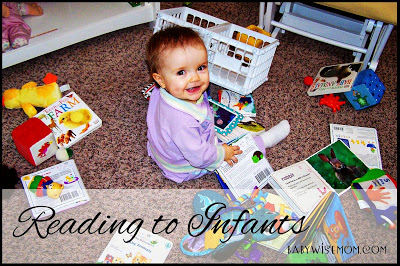 |
| Kaitlyn at 11 months old at the end of independent playtime |
I am a huge advocate of reading to your children. Reading to your infant or toddler is not about trying to create a genius of a baby. This post contains affiliate links. It is about helping your child reach her own innate potential (see The Read-Aloud Handbook, page 50). Despite the recent story that reading to children gives them an unfair advantage (just don’t even get me started on that idea), I continue to fully support and encourage parents reading to their children daily. Rather than telling parents who read to their children that they should occasionally feel guilty about the unfair advantage they are bestowing on their children, let’s encourage parents who aren’t reading to their children to do so.
“Children hearing the most language will have the best chance of having the best language skills” (The Read-Aloud Handbook, page 50). I would love to see all children given this chance and opportunity to reach their full potential. It isn’t about being “better” than others; it is about being the best version of themselves.
Keep in mind that “…attention spans are not built overnight–they are built minute by minute, page by page, day by day” (The Read-Aloud Handbook, page 52). And by the way, that is a fantastic thing to keep in mind for all sorts of parenting activities and issues from discipline to chores.
For me in this age range, a huge part of why I read to these young ages is to start a habit and to foster a love for books. I want my children to have positive associations with reading and books, so always keep that in mind as you are reading to your little ones.
Birth to 4 Months
What you read to this age group is not important. It just matters that you are reading (The Read-Aloud Handbook, page 49). With my little ones, I read books geared toward babies, but you could read the newspaper. You could read aloud a book you are interested in. You could read aloud your scriptures. Just read out loud.
These young babies can’t move on their own, so really your baby has no choice but to listen. I like to read with baby on my lap, but if your baby gets squirmy and upset, go ahead and put baby on the floor and read. You could read during tummy time or while baby was at the gym. You could lay on your backs next to each other while you hold the book above you.
4-9 Months
Again, go for your number one goal to be that you hold your baby while reading. Don’t restrict your baby, but cuddle your baby.
Around 4 months old, babies start to have an interest in toys. By 6 months old, your baby will want to grab the book. A great idea is to let your baby hold a toy to chew on so the book doesn’t become a battle. A wise thing for these younger ones is to read board books rather than books with pages that can be ripped when those cute pudgy fingers grab hold of them. Sometimes you can even give baby a different book to hold while you read a book.
As your baby gets holder, he will want to be the one to turn pages, and he obviously will not know when to turn pages. This often starts up around 8 months old. Remember the idea of Substitution. It can be helpful to give baby a different book to turn pages in. Let baby have books in independent play so he can turn and turn pages to his hearts content. Try to maintain control over the reading experience and turning the pages when it is time. You can gently say, “Oh! Not yet. We will turn the page in just a minute.” Then allow your child to turn when it is time. But do maintain it as an enjoyable experience; sometimes you will allow your child to turn pages before the page is done, and that is okay. Do keep in mind that self-control is valuable, though:
Look for books that:
- Have colorful pictures
- Have exciting sounds in the words
- Have a rhythmic beat
- Rhyme (Mother Goose
and Dr. Seuss are excellent)
- Are short
10-12 Months
During these months, the child will grow more and more interested in helping turn pages. The child will also grow more and more interested in the book. You can start asking your child to point to certain things. You can point at things and ask, “What is that?” or “What sound does a pig make?” Of course, you will have needed to introduced those things before asking your child to answer those questions. Your child will start by mimicking the things you teach and will progress to being able to answer questions.
More from the Read Aloud Handbook:
- Book Recommendation: The Read Aloud Handbook
- Building Vocabulary in Children
- Preparing for Kindergarten {Now}
- Read 30 Minutes a Day
- Reading While Pregnant
- Sustained Silent Reading (SSR)
- Teaching Children: Whose Job Is It?
- Teaching Children to Love to Read
- What Age Should You Start Reading To Your Child?
- Why Read Aloud?
 Dr. Seuss's Beginner Book B...Shop on Amazon
Dr. Seuss's Beginner Book B...Shop on Amazon Lucy Cousins' Book of Nurse...Shop on Amazon
Lucy Cousins' Book of Nurse...Shop on Amazon Nursery Rhymes: with a Sing...Shop on Amazon
Nursery Rhymes: with a Sing...Shop on Amazon The Read-Aloud Handbook: Se...Shop on Amazon
The Read-Aloud Handbook: Se...Shop on Amazon
